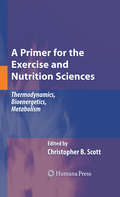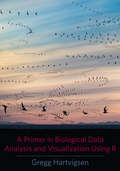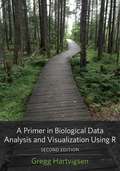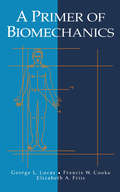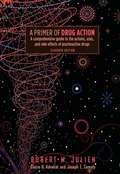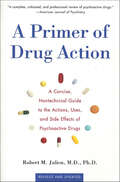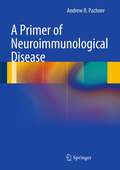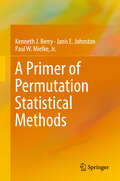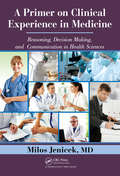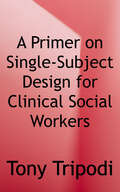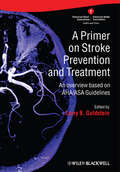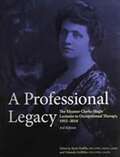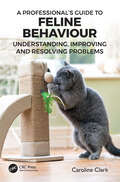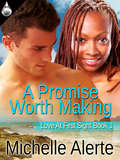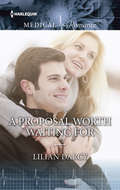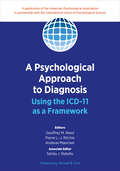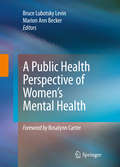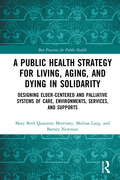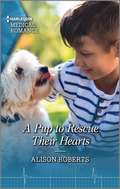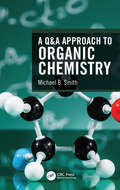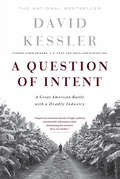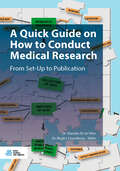- Table View
- List View
A Primer for the Exercise and Nutrition Sciences: Thermodynamics, Bioenergetics, Metabolism
by Christopher B. ScottThe subject of thermodynamics is rarely found in Nutrition and Exercise Physiology textbooks. Yet this material is fundamental to any serious inquisition concerning energy exchange. This book provides a fresh approach to the study of energy expenditure by introducing the latest concepts in open system thermodynamics and cellular to whole-body energy exchange. The text traces biological energy exchange, from the molecules in the food we eat to the energy demands of rest, physical exertion and its recovery. The carefully researched text advances traditional exercise physiology concepts by incorporating contemporary thermodynamic and cellular physiology principles into the context of a 'working' metabolism. This book is written for upper level undergraduate and graduate students, but will also appeal to exercise physiologists, registered dieticians and nutritionists, and applies to cardiac rehabilitation, exercise science and health fitness programs.
A Primer in Biological Data Analysis and Visualization Using R
by Gregg HartvigsenR is the most widely used open-source statistical and programming environment for the analysis and visualization of biological data. Drawing on Gregg Hartvigsen's extensive experience teaching biostatistics and modeling biological systems, this text is an engaging, practical, and lab-oriented introduction to R for students in the life sciences.Underscoring the importance of R and RStudio in organizing, computing, and visualizing biological statistics and data, Hartvigsen guides readers through the processes of entering data into R, working with data in R, and using R to visualize data using histograms, boxplots, barplots, scatterplots, and other common graph types. He covers testing data for normality, defining and identifying outliers, and working with non-normal data. Students are introduced to common one- and two-sample tests as well as one- and two-way analysis of variance (ANOVA), correlation, and linear and nonlinear regression analyses. This volume also includes a section on advanced procedures and a chapter introducing algorithms and the art of programming using R.
A Primer in Biological Data Analysis and Visualization Using R
by Gregg HartvigsenR is the most widely used open-source statistical and programming environment for the analysis and visualization of biological data. Drawing on Gregg Hartvigsen’s extensive experience teaching biostatistics and modeling biological systems, this text is an engaging, practical, and lab-oriented introduction to R for students in the life sciences.Underscoring the importance of R and RStudio in organizing, computing, and visualizing biological statistics and data, Hartvigsen guides readers through the processes of correctly entering and analyzing data and using R to visualize data using histograms, boxplots, barplots, scatterplots, and other common graph types. He covers testing data for normality, defining and identifying outliers, and working with non-normally distributed data. Students are introduced to common one- and two-sample tests as well as one- and two-way analysis of variance (ANOVA), correlation, and linear and nonlinear regression analyses. This volume also includes a section on advanced procedures and a chapter outlining algorithms and the art of programming using R.This second edition has been revised to be current with the versions of R software released since the book’s original publication. It features updated terminology, sources, and examples throughout.
A Primer of Biomechanics
by George L. Lucas Francis W. Cooke Elizabeth A. FriisThis is the first volume of its kind to present the principles of biomechanics with a highly clinical orientation. Dr. Lucas and his colleagues have assembled a practical guide using case presentations to make this very technical and complicated material attractive to the orthopaedic resident and practitioner. This "user-friendly" text is further enhanced by well integrated chapters covering all the basic materials and the latest information of this rapidly evolving field. Each case presentation is followed by a detailed, but easily understandable explanation of the biomechanical principles involved and includes protocols for treatment. A must-have for orthopaedic residents and practitioners.
A Primer of Drug Action: A Comprehensive Guide to the Actions, Uses, and Side Effects of Psychoactive Drugs (11th edition)
by Robert M. JulienA definitive guide to the pharmacology of drugs that affect the mind and behavior with over 40% new research citations. A clearer and current presentation on the mechanisms of drug action, etiologies of major psychological disorders, rationales for drug treatment, and the uses of psychopharmacology in patient care.
A Primer of Drug Action: A Concise Nontechnical Guide to the Actions, Uses, and Side Effects of Psychoactive Drugs
by Robert M. JulienSince 1975, Robert Julien's A Primer of Drug Action has been the definitive guide to the effects of psychoactive drugs on the brain and on behavior. Now fully updated, this popular guide continues to lead the way through a rapidly changing field, providing readers with a clear, contemporary, and objective look at every drug and medication that either positively or adversely affects brain function. This edition includes important new information on:-Herbal medications-Drug therapy for behavioral and anxiety disorders-Clinical practice guidelines for treating psychological disorders-Depression and the action of antidepressant drugs-The use of newer anticonvulsants in the treatment of bipolar disorder, pain syndromes, and behavioral disorders-Drug therapy for children, adolescents and the elderly-"New generation" antipsychotic agentsAuthoritative, comprehensive, and suitable for those with little background in biology, A Primer of Drug Action is an indispensable source of information for anyone interested in drug use, abuse, and education.
A Primer of Neuroimmunological Disease
by Andrew R. PachnerA Primer of Neuroimmunological Disease is a significant new resource for anyone interested in conditions such as multiple sclerosis(MS), myasthenia gravis, and neurological infections. It is a practical and balanced guide to the diagnosis and treatment of neuroimmunological disease. A Primer of Neuroimmunological Disease distinguishes itself by providing a range of features not generally included in texts on neuroimmunology. These include broad presentation of information in the form of figures and tables; strong cohesion among topics by focusing on a few prototypic neuroimmunological diseases, which serve as a foundation from which to explore other neuroimmunological diseases; a single author perspective, with references across chapters; and a focus on the overlap between neuroimmunological and neuroinfectious diseases. Neurologists, immunologists, infectious disease specialists, neuroscientists and others interested in neuroimmunological diseases such as MS will find A Primer of Neuroimmunological to be a state-of-the-art resource.
A Primer of Permutation Statistical Methods
by Kenneth J. Berry Janis E. Johnston Paul W. Mielke, Jr.The primary purpose of this textbook is to introduce the reader to a wide variety of elementary permutation statistical methods. Permutation methods are optimal for small data sets and non-random samples, and are free of distributional assumptions. The book follows the conventional structure of most introductory books on statistical methods, and features chapters on central tendency and variability, one-sample tests, two-sample tests, matched-pairs tests, one-way fully-randomized analysis of variance, one-way randomized-blocks analysis of variance, simple regression and correlation, and the analysis of contingency tables. In addition, it introduces and describes a comparatively new permutation-based, chance-corrected measure of effect size. Because permutation tests and measures are distribution-free, do not assume normality, and do not rely on squared deviations among sample values, they are currently being applied in a wide variety of disciplines. This book presents permutation alternatives to existing classical statistics, and is intended as a textbook for undergraduate statistics courses or graduate courses in the natural, social, and physical sciences, while assuming only an elementary grasp of statistics.
A Primer on Clinical Experience in Medicine: Reasoning, Decision Making, and Communication in Health Sciences
by MD, Milos JenicekMastery of quality health care and patient safety begins as soon as we open the hospital doors for the first time and start acquiring practical experience. The acquisition of such experience includes much more than the development of sensorimotor skills and basic knowledge of the sciences. It relies on effective reasoning, decision making, and comm
A Primer on Single-Subject Design for Clinical Social Workers
by Tony TripodiThe move to managed care in the human services has increased the popularity of single-subject design -- an adaptable methodology that is information based, outcome oriented, and consumer driven. <p><p>Special Features: Contains 39 tables and 55 figures; Demonstrates how clinicians can use the model to monitor treatment effectiveness; Promotes accountability in clinical practice.
A Primer on Stroke Prevention and Treatment
by Larry B. GoldsteinSociety-sanctioned guidelines are valuable tools, but accessing key information can be a daunting task. This book illuminates a clear path to successful application of the American Heart Association/American Stroke Association guidelines. Organized for fast reference, this new volume helps practitioners improve patient care.
A Professional Legacy: The Eleanor Clarke Slagle Lectures in Occupational Therapy, 1955-2010
by Barbara E. ChandlerAs its title suggests, this book contains a true legacy in the tradition of one of its greatest occupational therapy pioneers, Eleanor Clarke Slagle (1876-1942). The American Occupational Therapy Association recognized this pioneer's influence by establishing its highest award in her honor in 1953. <p><p> This compilation presents the 47 Eleanor Clarke Slagle Lectures, and while each stands firm as its own solid example of scholarship, when read sequentially they form a unique record of the steady progress and increasing sophistication of occupational therapy. The lectures contain history, leadership, mentoring, encouragement, admonishment, philosophy, and practical guidance. Above all, they reflect Slagle's vision of the integration of theory, philosophy, and spirit from which practitioners, educators, and students can draw inspiration.
A Professional Study and Resource Guide for the CRNA 2nd Edition
by Scot D. Foster Margaret Faut CallahanThe comprehensive resource for practicing and student nurse anesthetists covers all aspects of a career in nurse anesthesia.
A Professional’s Guide to Feline Behaviour: Understanding, Improving and Resolving Problems
by Caroline ClarkA Professional's Guide to Feline Behaviour is an invaluable resource for the feline professional, yet written in such an accessible way that it would be of interest to anyone who shares their life with a cat and wants to gain a deeper understanding of their behaviour.The book is presented in easy-to-navigate sections, each packed with practical advice and the colour illustrations, tables and graphics throughout make it approachable for every type of reader.What this guide offers: A greater understanding of cats and how to meet their needs. How to recognise and mitigate negative emotions and deal with challenges that cats face both at home and particularly in the workplace. How to analyse feline behaviour accurately, with a view to designing a tailored behaviour modification plan. Comprehensive information on common, and not so common, problematic feline behaviours. The fundamentals of learning theory, with step-by-step training guides. Real-life case studies, accompanied by behaviour plans that integrate clinically proven methods to help manage or resolve a range of behaviour issues. Written by Caroline Clark, a Registered Clinical Animal Behaviourist and RCVS listed veterinary nurse, this well-researched book draws from her knowledge and professional experiences, offering a unique insight into feline behaviour.
A Promise Worth Making
by Michelle AlerteWatch the sparks fly when a woman who doesn't believe in love, family, or happily-ever-after meets a hopeless romantic who does. Michelle Alerte brings you Book 1 of her new romance series Love At First Sight. A Promise Worth Making will make you laugh, cry, and cheer our hero on to victory.Dr. Rachelle Joseph has no time to dally with a man. She is on her way to Haiti to contribute her medical expertise in the aftermath of the earthquake. Having grown up in a New York orphanage, neither fostered nor adopted, independent Rachelle has recently discovered her Haitian heritage and seeks to embrace it. But life throws her a curveball. On the plane to Port-au-Prince, Rachelle meets Nicolas Marchand, a handsome French architect who, for some reason, gets her heart racing.Nicolas' father had always told him the Marchand men were "gifted with knowing, when they know, that they know" when they meet the woman with whom they'll fall in love. Though this had been true for his father, grandfather, and great-grandfather, Nicolas had never truly believed this would happen to him--until Rachelle Joseph, that is.The hard part now is convincing the lucky lady the two of them belong together in spite of Rachelle's trust issues and fear of depending on another person. Will Rachelle overcome her determination to keep control of her life by shutting Nicolas out, or will he persuade her that loving and trusting another person is better than living only on the surface of life?Content Notes: Spicy, Contemporary, Interracial, Multi-Cultural
A Proper Knowledge
by Michelle Latiolais"Every passionate reader lives for that first page of a book that alerts her, straightaway, she'll be sorry when the book ends. So it is with Michelle Latiolais' astonishing, sparklingly intelligent new novel...The work strives, with bold zest, to arrive at the marrow of things...Latiolais triumphs, folding the work's clinical ruminations into the story's delicious batter. Powerfully recommended."--Antioch Review "The novel counts--in elegant and sometimes elegiac prose--the shadowy and elusive opportunities for redemption."--Ron Carlson, author of Five Skies "A ravishing intelligence is at work in these pages."--Elizabeth Tallent, author of Honey, on Even Now A gifted psychiatrist, haunted by the death of his young sister, seeks to penetrate the mysteries of childhood autism in this beautifully written, insightful investigation into the misunderstood pathways of the brain--and the heart.
A Proposal Worth Waiting For
by Lilian DarcyA family for keeps Time with his son is precious to surgeon Nick Devlin. He knows he hasn't been there enough for his boy, but going to Crocodile Creek Kids' Camp will change all that. The last person Miranda Carlisle expects to see at the camp is Nick. Their one passionate night together in medical school left her brokenhearted. She's determined to keep her distance, yet watching him struggle to bond with his child tugs at her heartstrings. She knows she can help Nick be a father to his son, but opening her heart to him again will take courage. Luckily, the warmth of Nick's smile is making her feel brave....
A Psychiatrist Works with Blindness
by Louis S. CholdenEach patient will react to blindness in a manner characteristic for his personality. He will react to it as an emergency situation which will have most serious consequences for his future life plans. Besides the emergency aspect of the loss of vision, blindness in itself holds a number of special and deep meanings to the patient which must be considered in attempting to understand its effects. These meanings may be discussed from the psychologic, social and vocational points of view. But, because the patient will react to the problem of blindness in a way which is peculiar to him, one might predict within certain limits what the patient's reactions will be, providing we understand his personality structure.
A Psychological Approach to Diagnosis: Using the ICD-11 as a Framework
by Andreas Maercker Pierre L.-J. Ritchie Geoffrey M. Reed Tahilia J. RebelloThis groundbreaking volume, published by the American Psychological Association in partnership with the International Union of Psychological Science, provides a detailed guide to clinical diagnosis by psychologists and other health professionals based on the eleventh revision of the World Health Organization's International Classification of Diseases (ICD-11). The ICD-11 was adopted by the World Health Assembly in 2019 and came into effect as the global standard for health information and reporting in 2022. The ICD is the diagnostic system for mental disorders most widely used by mental health professionals around the world in their day-to-day clinical practice. This edited volume offers a step-by-step approach to diagnosis, giving mental health professionals around the world the tools they need to apply ICD-11 diagnostic requirements for mental, behavioral, and neurodevelopmental disorders as the basis for delivering high quality, evidence-informed care. A psychological approach to diagnosis is a conceptually driven, person-oriented, biopsychosociocultural formulation that integrates pertinent history, behavior, symptoms, phenomenology, and functioning. A psychological approach focuses on psychological mechanisms and principles as an aspect of diagnostic practice and case formulation, regardless of professional discipline. The chapters of this book cover the major groupings of mental disorder as well as related areas that are important parts of psychological practice, such as sexual dysfunctions, sleep-wake disorders, and relationship problems and maltreatment. The authors of this book are leading global experts in each area, many of whom were integrally involved in developing the respective sections of the ICD-11. Authors describe the overarching logic for the classificatory arrangement and the elements of a psychological approach to the set of disorders discussed in each chapter, including psychological models for conceptualizing their symptoms and recommendations for psychological assessment. The chapters also discuss presentations and symptom patterns for each major group of disorders, specifiers and subtypes, the threshold between normal variation and disorder, differential diagnoses, co-occurring disorders, developmental course, cultural and contextual considerations, and gender-related features. A Psychological Approach to Diagnosis is the first comprehensive training resource on WHO&’s ICD-11 classification of mental, behavioural and neurodevelopmental disorders. It provides practicing psychologists and other mental health professionals, primary care clinicians, educators, and trainees with essential tools for the competent practice of diagnosis using the ICD-11 as a framework.
A Public Health Perspective of Women’s Mental Health
by Marion Ann Becker Bruce Lubotsky LevinA Public Health Perspective of Women's Mental Health Edited by Bruce Lubotsky Levin and Marion Ann Becker As many as one-half of all women in the U.S. will experience some form of mental illness in their lives--an especially distressing fact when health care budgets are in flux, adding to existing disparities and unmet health needs. Written from a unique multidisciplinary framework, A Public Health Perspective of Women's Mental Health addresses today's most pressing mental health challenges: effective treatment, efficient prevention, equal access, improved service delivery, and stronger public policy. Eminent clinicians, researchers, academicians, and advocates examine the effects of mental illness on women's lives and discuss the scope of clinical and service delivery issues affecting women, focusing on these major areas: Epidemiology of mental disorders in girls, female adolescents, adult women, and older women. Selected disorders of particular concern to women, including depression and postpartum depression, eating disorders, menopause, chemical dependence, and HIV/AIDS. Mental health needs of women in the workplace, rural areas, and prisons. Racial and ethnic disparities and their impact on service delivery. Parenting and recovery issues in mothers with mental illness. Women's mental health services in an era of evidence-based medicine. Improving women's health in today's technological climate. A Public Health Perspective of Women's Mental Health is a resource of immediate importance to professionals and graduate students in the public health, health administration, health disparities, social work, behavioral health, and health services research fields, as well as nursing, community/health psychology and community/public psychiatry.
A Public Health Strategy for Living, Aging and Dying in Solidarity: Designing Elder-Centered and Palliative Systems of Care, Environments, Services and Supports (Best Practices for Public Health)
by Mary Beth Morrissey Melissa Lang Barney NewmanWith more people living longer lives, there is increased importance in the health care industry on improving services for the elderly. This comprehensive book gives an expert overview of the topics and challenges, along with imperative ethical and legal frameworks. The book also details existing programs and benefits in relation to a realistic portrayal of population needs. Other important issues are covered such as long-term palliative care and hospice, other vulnerable populations, elder abuse, public-private collaboration, evidence-based policy-making, and much more.
A Pup to Rescue Their Hearts: A Pup To Rescue Their Hearts (twins Reunited On The Children's Ward) / A Surgeon With A Secret (twins Reunited On The Children's Ward) (Twins Reunited on the Children's Ward #1)
by Alison RobertsCould an unlikely bond……be the answer to their dreams?Nurse Stevie hates feeling out of her depth. But with a new job and a son who’s struggling to settle in, she needs help. She just didn’t expect it to come in the shape of her boss and one adorable dog! On paper, Josh is everything Stevie should avoid. But beneath his charming exterior is a heart also in need of rescuing…From Harlequin Medical: Life and love in the world of modern medicine.Twins Reunited on the Children’s WardBook 1: A Pup to Rescue Their HeartsBook 2: A Surgeon with a Secret
A Q&A Approach to Organic Chemistry
by Michael B. SmithA Q&A Approach to Organic Chemistry is a book of leading questions that begins with atomic orbitals and bonding. All critical topics are covered, including bonding, nomenclature, stereochemistry, conformations, acids and bases, oxidations, reductions, substitution, elimination, acyl addition, acyl substitution, enolate anion reactions, the Diels–Alder reaction and sigmatropic rearrangements, aromatic chemistry, spectroscopy, amino acids and proteins, and carbohydrates and nucleosides. All major reactions are covered. Each chapter includes end-of-chapter homework questions with the answer keys in an Appendix at the end of the book. This book is envisioned to be a supplementary guide to be used with virtually any available undergraduate organic chemistry textbook. This book allows for a "self-guided" approach that is useful as one studies for a coursework exam or as one reviews organic chemistry for postgraduate exams. Key Features: Allows a "self-guided tour" of organic chemistry Discusses all important areas and fundamental reactions of organic chemistry Classroom tested Useful as a study guide that will supplement most organic chemistry textbooks Assists one in study for coursework exams or allows one to review organic chemistry for postgraduate exams Includes 21 chapters of leading questions that covers all major topics and major reactions of organic chemistry
A Question Of Intent: A Great American Battle With A Deadly Industry
by David KesslerTobacco companies had been protecting their turf for decades. They had congressmen in their pocket. They had corrupt scientists who made excuses about nicotine, cancer and addiction. They had hordes of lawyers to threaten anyone-inside the industry or out-who posed a problem. They had a whole lot of money to spend. And they were good at getting people to do what they wanted them to do. After all, they had already convinced millions of Americans to take up an addictive, unhealthy, and potentially deadly habit. David Kessler didn't care about all that. In this book he tells for the first time the thrilling detective story of how the underdog FDA-while safeguarding the nation's food, drugs, and blood supply-finally decided to take on one of the world's most powerful opponents, and how it won. Like A Civil Action or And the Band Played On, A Question of Intent weaves together science, law, and fascinating characters to tell an important and often unexpectedly moving story. We follow Kessler's team of investigators as they race to find the clues that will allow the FDA to assert jurisdiction over cigarettes, while the tobacco companies and their lawyers fight back-hard. Full of insider information and drama, told with wit, and animated by its author's moral passion, A Question of Intent reads like a Grisham thriller, with one exception-everything in it is true.
A Quick Guide on How to Conduct Medical Research: From Set-Up to Publication
by Marieke M. ter Wee Birgit I. Lissenberg-WitteThis book is an essential guide on how to conduct human medical research with a focus on the fundamental concepts of contemporary biostatistics and epidemiology. It provides an overview of all necessary steps: from setting up research, analyzing collected data and publishing results as a scientific paper and also in finding the appropriate audience for a completed study. This comprehensive but compact book covers the writing of research proposals, choosing research designs, describing collected data, and understanding various techniques of inferential statistics. It is written from an applied point-of-view: two studies are used as example, which guide the reader through all steps, focusing on the interpretation of the results using SPSS (Statistical Package for the Social Sciences) output. A Quick Guide on How to Conduct Medical Research is not only an indispensable resource for PhD students, researchers as well as physicians performing their own research, but also for any readers of medical research who would like a deeper understanding of scientific publications. It can also be used in educational programs in the school of medicine, health sciences, human movement sciences, medical biology and paramedical schools.
